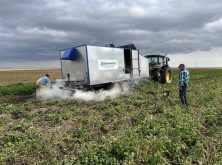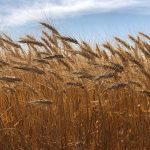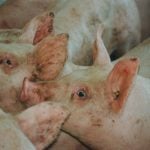Get out and scout. Next to diversifying your rotations and herbicide selection as much as possible, it’s a critical part of managing herbicide-resistant weeds on your farm in 2022. Scouting is important because without an accurate and thorough picture of what resistant species exist in your fields, you can’t make the best management decisions. More knowledge is more power as you do what you can this year to curb whatever resistance is developing on your farm.
“There’s a perception out there that resistance comes from somewhere else — and it can do so through pollen spread — but growers need to fully realize that there is plenty of resistance development going on in their fields every year,” says Saskatchewan provincial weed specialist Clark Brenzil.
Read Also

Cancer agency reclassifies another herbicide ‘probably carcinogenic’
The WHO’s cancer research agency has now put atrazine, a herbicide well known to corn growers, in the same potential-hazard category where the agency put glyphosate.
Among the most serious weed resistance concerns on the Prairies right now are wild oat and green foxtail. Brenzil reports both wild oat and green foxtail are showing resistance to Group 1 and 2 herbicides in the same plant, and green foxtail plants have also been found with resistance to Group 3 chemistries. Waterhemp, which was identified in 2019 in Manitoba, seems to develop resistance fast, and growers are advised if they find it they should deal with it as soon as possible.
Kochia is another concern. “Up to 20 per cent of kochia is dicamba resistant now,” says Brenzil. “In some places in the United States, there is kochia resistance to Group 5, also.”
When to scout
There are three periods during the growing season to scout for resistance. The first is after planting (after the spring pre-emergence herbicide burn-down) and the second is after the post-emergence herbicide spray application. The other time is before harvest when checking for insect and disease pests and crop maturity.
“Herbicides vary for how quickly they kill plants,” explains Shaun Sharpe, a research scientist at Agriculture and Agri-Food Canada (AAFC) in Alberta. “As a general rule, symptomology should be quite visible and progressing by two to three weeks for post-emergence herbicides and three to four weeks after planting for pre-emergence herbicides applied in the spring. Slower-acting herbicides like glyphosate or synthetic auxins may not completely kill plants at this timing but injury should be noticeable.”
During scouting, check for areas that have “a single weed species that’s not dying,” advises Brenzil. “That’s likely resistance. It’s very unlikely that it’s resistance if there are several species that have survived spraying.”

Sharpe concurs. “If several species are surviving, this may indicate a misapplication. Symptomology should be developing on sensitive plants in close proximity to resistant plants with a successful application. Resistant plants may still be injured but signs of regrowth will be present. Check for patterns in the field as a clogged nozzle, or a small gap between passes may also occur creating a narrow strip where plants survive.”
Before concluding there is a herbicide resistance problem, Sharpe and Brenzil advise farmers to consider the following:
- Check sprayer calibration and any possible errors or spray pattern disruptions.
- Confirm full label rates were applied.
- Was there rainfall before the herbicide could become rainfast?
- With respect to staging and coverage, were the plants large enough when sprayed or too large?
- Was water quality checked? Bicarbonate or hardness in carrier water may cause herbicides to be deactivated. Leaving herbicides (especially Group 2 sulfonylurea types) in carrier water for too long can cause them to break down.
- With respect to tank-mix compatibility, was a surfactant or adjuvant applied and should there have been one? Were there any new tank-mix partners where herbicide antagonism could have occurred?
How to prevent resistance
Brenzil says growers should use multiple modes of action to target any particular weed in order to reduce the risk of resistance developing.
Herbicide resistance is largely “a numbers game,” Sharpe adds. “There is a risk of herbicide resistance development with every plant killed by a herbicide, so rotating modes of action and applying full label rates to the proper staging is good herbicide stewardship for delaying and managing resistance.” In addition, looking at the big picture, lowering infestations and preventing weeds from forming seed to refill the seed bank through non-chemical means will help reduce the risk of herbicide resistance from occurring.
If you have patches of kochia in saline areas beside a field, you have an “ideal” nursery for herbicide resistance, says Brenzil. “These kochia will get some spray at progressively lower rates the further away from the field they are. Some kochia will be naturally able to survive the lower dose and cross with others building higher and higher levels of resistance, until eventually they can tolerate the field rate,” he says. “To avoid this, plant these saline areas with saline-tolerant perennial forages. Kochia doesn’t compete well with the heavier cover provided by perennial forage or narrow row spacing and high seeding rate in the field itself.”
He also advises planting forages in saline areas of your fields where profit margins are negative or breaking even. “Take a good look at your yield maps and think about why you are planting crop seed there if you are just breaking even and may be giving kochia a leg up with developing resistance. With the dry weather the last few years, there’s the urge to try and capture additional acreage in those low slough areas in search of moisture, but it’s better to plant a saline-tolerant perennial forage then lift the seeder as you go through and let those areas be. Maybe cut the area for hay if it’s large enough, but if the areas are small just leave the cover.”

Brenzil reports there is a range of salt-tolerant forages such as tall fescue and green wheatgrass available. Green wheatgrass is a naturally occurring hybrid of bluebunch wheatgrass and quackgrass. A new variety has been bred by Bill Biligetu at the University of Saskatchewan to have higher levels of seed production than previous varieties.
Resistant downy brome, an update
Downy brome is an annual grass that’s usually a problem in winter cereals in semi-arid areas of Alberta. It was confirmed to be resistant on a farm in Taber County (east of Lethbridge) in 2021 in Roundup Ready canola, surviving seven to 12 times the normal rate in lab tests done by Charles Geddes, an AAFC weed scientist.
“We need to do a full survey to understand the extent of the issue, whether it’s on neighbouring farms,” says Geddes. “In terms of potential to spread, the biggest threat is spreading weed seed through equipment contamination. It’s good news that it’s a self-pollinated species, so the resistance trait is less likely to transfer through pollen. I have some thoughts about the mechanism of resistance, but I’m not sure about that yet.”
Geddes has also found the Group 1 active ingredient quizalofop, which can be added to herbicides with other modes of action, controls glyphosate-resistant (and normal populations) of downy brome. He’s also found glufosinate mixed with Clethodin works well and advises in fields where glyphosate-resistant downy brome could be an issue it will be important for farmers to rotate to a glufosinate-resistant canola.















